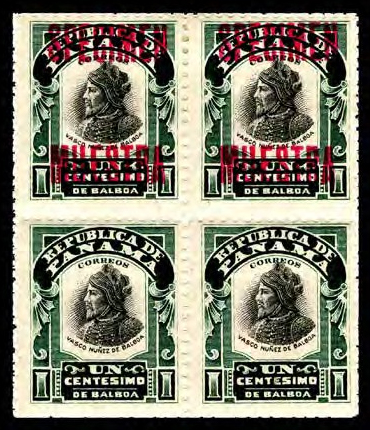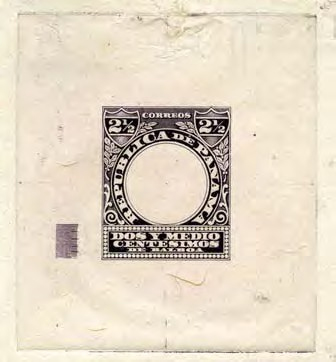Volume 1: The ½ and 1 centesimo stamps (Scott Number 185 – 186) on 50 pages
This volume includes:
- Artwork of vignettes and frames
- Die proof of vignettes (stone and steel engraving)
- Rejected die proofs of vignettes
- Die proof of frames (stone and steel engraving, different colors and rejected die proofs)
- Plate proofs of frames including different colors
- Die proof of stamps (plate proof of stamp, imperforate and perforate both horizontal and vertical and in different colors)
- Essays
- Mint stamps, inverts and UPU specimens
- Postal Card designs and proofs
- One trial color sheet of 200 of the vignette of the flag (only one known)
½ centesimo stamp – The Panamanian flag represented the political situation of the time: the blue block for the Conservative Party, red for the Liberal Party, and the white for peace and purity. The stars stood for the new republic: the blue star for purity and honesty; the red star for authority and law.

- centesimo stamp - Vasco Núñez de Balboa, (c.1475 – 1519), was the first person honored on this series of stamps of the Republic of Panama. On September 25, 1513, from a lofty peak in the Darién Country, after having made his way through the nearly impenetrable jungle, he was the first European to view the Mar del Sur, also known as the Pacific Ocean. Despite many honors, his glorious career as an explorer came to an end in January 1519, when he was executed following conspiracy charges.
Volume 2: The 2, 2½, and 5 centesimos stamps (Scott Number 187 – 189) on 53 pages
This volume includes:
- Artwork of vignettes and frames
- Die proof of vignettes (stone and steel engraving)
- Rejected die proofs of vignettes
- Die proof of frames (stone and steel engraving, different colors and rejected die proofs)
- Plate proofs of frames including different colors
- Die proof of stamps (plate proof of stamp, imperforate and perforate both horizontal and vertical and in different colors)
- Essays
- Mint stamps, inverts and UPU specimens
- Trial color sheets of 100 of the 2, 2½, and 5 centesimos stamps

- centesimos stamp - Antonio Fernandez de Córdoba y Mendoza (?? – 1673) appears on this stamp. A few months after Welsh privateer Captain Henry Morgan sacked the original and old City of Panama, Fernandez de Córdoba arrived from Spain to assume the head of government with the title of President and Captain General. He governed from December 1671 until his death on April 8, 1673. The founding of the new city of Panama some 12 miles from Old Panama occurred during his administration.

2½ centesimos stamp - The Panamanian Coat of Arms center section contains the Isthmus of Panama. The official description of the heraldic design is as follows:
“It rests on a green field, symbol of the vegetation; it is of pointed form and it is intervened as far as the division. The center shows the Isthmus with its seas and sky, in which the moon begins to rise above the waves and the sun begins to hide behind the mountain, marking thereby the solemn hour of the declaration of our independence. The head is divided in two quarters: in the one of the right hand, in the silver field, a sword and a gun are hung meant as abandonment for always to the civil wars, causes of our ruin; in the one of the left-hand side, and on field of gules, a crossed shovel and a grub hoe are shown shining, to symbolize the work.
“The end of the coat of arms also is divided in two quarters: the one of the right- hand side, in blue field, shows a cornucopia, emblem of the wealth; and the one of the left-hand side, in field of silver, the winged wheel, symbol of the progress. Behind the shield and covering it with his opened wings, is the eagle, emblem of the sovereignty, the head turned towards the left, and takes in the tip a silver tape, which hangs from right to left. On the tape the following motto is printed ‘Pro Mundi Beneficio’.
“On the eagle, in arc form, seven gold stars go in representation of the provinces in which the Republic is divided.” (Law 64 of June 4, 1904)

5 centesimos stamp - Justo Arosemena (1817 – 1896) appears in the vignette of the 5 centesimos stamp. He was a jurist, diplomat, distinguished writer and stands as one of the most illustrious personalities of the Department of Panama. He helped create the Sovereign State of Panama and its Constitution of 1863, was a Minister to France and England, and, in 1879 and 1880 was Colombia’s Minister to the United States. From 1888 until his death February 23, 1896, he served as the attorney for the Panama Railroad Company.
Volume 3: The 8, 10, 25 and 50 centesimos stamps (Scott Number 190-193) on 53 pages
This volume includes:
- Artwork of vignettes and frames
- Die proof of vignettes (stone and steel engraving)
- Rejected die proofs of vignettes
- Die proof of frames (stone and steel engraving, different colors and rejected die proofs)
- Plate proofs of frames including different colors
- Die proof of stamps (plate proof of stamp, imperforate and perforate both horizontal and vertical and in different colors)
- Essays
- Mint stamps, inverts and UPU specimens

8 centesimos stamp - Manuél José Hurtado (1821 – 1887), Panama’s distinguished educator, appears on the 8 centesimos stamp. Trained as a civil engineer at the University of Paris, Don Manuél chose education as his life’s work. In 1868, he became the Director of the first government- supported institution of learning. He gave lands for the construction of schools and money for their maintenance, established the first public library in 1870, and a year later, created the men’s Normal school. In 1872, Hurtado was named President of the Provincial Council for Education, in 1877, Director of Public Instruction and for a time served on the Board of the French Canal Company.

10 centesimos stamp - José de Obaldía (1806 – 1889), one of Panama’s most distinguished statesmen, was illustrated on the 10 centesimos stamp. He was Senator, governor, Vice-President and
President of Colombia for five terms. From 1834 – 1838, while a member of the Congress at Bogota, Obaldia gave strong support for the construction of an Isthmus waterway and the survey being made by the Biddle–Thiery party sent to the Isthmus by U.S. President Andrew Johnson.

25 centesimos stamp - Tomás José Ramón del Carmen de Herrera y Pérez Dávila (1804 - 1859) was a statesman and general who became the first Head of State of the Free State of the Isthmus, now Panama. In November 1840, during a civil war that had begun as a religious conflict, the isthmus was under the leadership of General Tomás de Herrera who declared its independence as did multiple other local authorities. In March 1841, the State of Panama adopted the name ‘Estado Libre del Istmo’, or the Free State of the Isthmus. The new state established external political and economic ties and by March 1841, had drawn up a constitution which included the possibility for Panama to rejoin New Granada, but only as a federal district. De Herrera’s title was changed first to Superior Chief of State in March 1841, and then in June 1841, to President. By the time the civil conflict ended and the government of New Granada, along with the government of the Isthmus, had negotiated the Isthmus’ reincorporation to the union, Panama's First Republic had been free for 13 months. Reunification occurred on December 31, 1841.

50 centesimos stamp - General José Pedro Antonio de Fábrega (1774 – 1841) appeared in the vignette of this stamp. After about 320 years under the rule of the Spanish Empire, on 10 November 1821, independence from Spain was shouted from the small town of La Villa de la Santos, today known as La Heroica. Later, on 28 November, presided over by Colonel José de Fábrega, a National Assembly was convened and officially declared the independence of the Isthmus of Panama from Spain, and announced the decision to join New Granada, Ecuador and Venezuela in Bolivar’s recently founded Republic of Colombia. In August 1831, military forces under the command of Colonel Tomás Herrera reestablished ties with New Granada.
